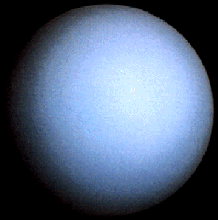The Surface and Interior
of Uranus
 Uranus has a relatively featureless appearance at visible
wavelengths. Even from Voyager 2 at a distance of 80,000 km there were few
distinguishable features. This is believed to be due to Uranus being further
from the Sun than Jupiter and Saturn, which means its temperature is lower (only
58 degrees Kelvin in the upper atmosphere). This decreases the liklihood of
chemical reactions making the colorful compounds that give the surface
features on
Jupiter and Saturn. In addition, the upper atmosphere is thought to have a
high-level petrochemical haze that obscures features lower in the atmosphere.
Uranus has a relatively featureless appearance at visible
wavelengths. Even from Voyager 2 at a distance of 80,000 km there were few
distinguishable features. This is believed to be due to Uranus being further
from the Sun than Jupiter and Saturn, which means its temperature is lower (only
58 degrees Kelvin in the upper atmosphere). This decreases the liklihood of
chemical reactions making the colorful compounds that give the surface
features on
Jupiter and Saturn. In addition, the upper atmosphere is thought to have a
high-level petrochemical haze that obscures features lower in the atmosphere.
The blue color is because of methane gas in the atmosphere, which absorbs red
and orange light strongly, leaving more blue light to be scattered to the
observer. The clouds are thought to be mostly methane ice, with a temperature
at the cloud tops of about -221 degrees Celsius.
Voyager 2 confirmed the suspicion that Uranus had a magnetic field. The field
is about 50 times stronger than that of the Earth and is tilted about 60
degrees with respect to the rotation axis. As a result, the magnetic field
moves like a corkscrew as Uranus rotates, as illustrated in the following
movie
(5 MB).
One hypothesis for this behavior of the magnetic field is that it originates in
a thin conducting shell outside the core of the planet rather than deep in the
core as for the Earth or Jupiter. The pressure would not be high enough for
the relevant conducting material to be metallic hydrogen. A mixture of water,
methane, and ammonia under sufficient pressure could provide the requisite
electrical conductor.
The magnetosphere contains belts of charged particles similar to
those of the Earth. The rings and most of the moons orbit within the
magnetososphere and thus are protected from the Solar wind.
 Uranus has a relatively featureless appearance at visible
wavelengths. Even from Voyager 2 at a distance of 80,000 km there were few
distinguishable features. This is believed to be due to Uranus being further
from the Sun than Jupiter and Saturn, which means its temperature is lower (only
58 degrees Kelvin in the upper atmosphere). This decreases the liklihood of
chemical reactions making the colorful compounds that give the surface
features on
Jupiter and Saturn. In addition, the upper atmosphere is thought to have a
high-level petrochemical haze that obscures features lower in the atmosphere.
Uranus has a relatively featureless appearance at visible
wavelengths. Even from Voyager 2 at a distance of 80,000 km there were few
distinguishable features. This is believed to be due to Uranus being further
from the Sun than Jupiter and Saturn, which means its temperature is lower (only
58 degrees Kelvin in the upper atmosphere). This decreases the liklihood of
chemical reactions making the colorful compounds that give the surface
features on
Jupiter and Saturn. In addition, the upper atmosphere is thought to have a
high-level petrochemical haze that obscures features lower in the atmosphere.